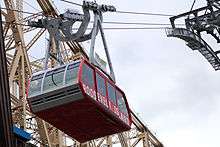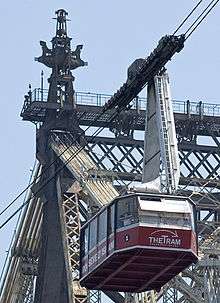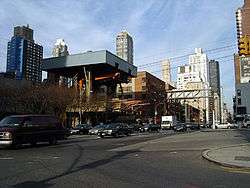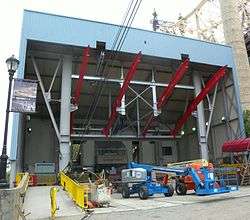Roosevelt Island Tramway
| Roosevelt Island Tramway | |
|---|---|
 | |
| Overview | |
| Status | Operational |
| Character | Aerial tramway |
| System | Pomagalski |
| Location | Manhattan, New York City, U.S. |
| Termini |
Upper East Side (west) Roosevelt Island (east) |
| Elevation | highest: 250 ft (76 m) |
| No. of stations | 2 |
| Open | May 17, 1976[1] |
| Reopened | November 30, 2010 |
| Operation | |
| Operator | Roosevelt Island Operating Corp. |
| Technical features | |
| Line length | 3,100 ft (940 m) |
| Operating speed | 17.9 mph (28.8 km/h) |
| Notes | Electric motor powering cable bullwheel |
The Roosevelt Island Tramway is an aerial tramway in New York City that spans the East River and connects Roosevelt Island to the Upper East Side of Manhattan. Prior to the completion of the Mississippi Aerial River Transit in May 1984[note 1] and the Portland Aerial Tram in December 2006, it was the only commuter aerial tramway in North America.[2]
Over 26 million passengers have used the tram since it began operation in 1976. Each cabin has a capacity of up to 110 people and makes approximately 115 trips per day. The tram moves at about 17.9 mph (28.8 km/h) and travels 3,100 feet (940 m) in 3 minutes. At its peak it climbs to 250 feet (76 m) above the East River as it follows its route on the north side of the Ed Koch Queensboro Bridge, providing views of the East Side of Midtown Manhattan. Two cabins make the run at fifteen-minute intervals from 6:00 a.m. to 2:00 a.m. (3:30 a.m. on weekends) and continuously during rush hours. It is one of the few forms of mass transit in New York City not run by the Metropolitan Transportation Authority, but uses that system's MetroCard and has free transfers to that system.
The tram is operated by LPOA (Leitner-Poma of America) on behalf of the Roosevelt Island Operating Corporation of the State of New York, a state public benefit corporation created in 1984 to run services on the island.
History
Early history

Roosevelt Island had been connected to Manhattan by a trolley line that crossed over the Queensboro Bridge from its opening in 1909. Trolleys to and from Queens stopped in the middle of the bridge to meet an elevator, which then took passengers down to the island. As the only connection to the rest of the city from the island, the trolley remained in service until April 7, 1957, long after most other trolley service had been dismantled in the city, and was the last trolley line in New York State; it was replaced by buses.[3] At that time, a bridge to Queens was completed, requiring a roundabout trip to reach Manhattan.
Beginning in the mid-1970s, Roosevelt Island was redeveloped to accommodate low- to mid-income housing projects, necessitating the construction of a new public transit connection to the city. The trolley tracks had deteriorated beyond repair and the Roosevelt Island subway station serving the island via the 63rd Street subway connection had not yet been completed. In 1971, the Urban Development Corporation retained Lev Zetlin Associates to select and design a transit connection to Roosevelt Island. James A O'Kon PE led the LZA team in carrying out a feasibility study and design. Three alternate modes were studied: a ferry, an elevator from the bridge, and the aerial tramway. The tramway was selected and the system was designed for bidding. Von Roll was selected to supply and erect the tram and its equipment. It was opened in July 1976 as a temporary solution for the island's commuting needs.[1] As the subway project fell further behind schedule, the "tram" became more popular and was converted into a permanent facility, and the tram held a monopoly for service between Roosevelt Island and the rest of Manhattan until the subway connection to the island was finally completed in October 1989.
After the 63rd Street Subway was completed, daily ridership declined sharply, from 5,500 daily riders in 1989 to 3,000 by 1993. The tram was closed from October 1993 to January 1994 for repairs.[4]
The tram was the last holdout for the use of tokens in the New York City transit system. Initially, it used a special token, which was later replaced by the standard variety for subways and buses. Although tokens were phased out in favor of the MetroCard by 2003, the tram did not start to accept MetroCards until March 1, 2004. The fare is the same as that on the buses and subways: U.S. $2.75 for a one-way trip, with free transfers to the subway and buses.[5] During the 2005 New York City transit strike, the tramway was one of the few intra-city public transportation systems still in operation, due to the fact that it is privately operated.
Breakdowns
On April 18, 2006, at about 5:22 p.m. EDT, the two trams were stuck over the East River for seven hours because of mechanical problems, trapping 69 people. Rescue baskets capable of holding up to 15 people were sent up to the stranded cable cars at 10:55 p.m., with children and elderly going first, and each rescue taking about 20 minutes. These baskets also carried supplies to the trams, such as blankets, baby formula, and food, for the remaining passengers.[6] Passengers on the Roosevelt Island–bound tram were rescued by about 2:55 a.m. on April 19, while those on the Manhattan-bound tram were not rescued until 4:07 a.m.[7]
The April 2006 incident had been the second time in eight months that the tram system lost power. On September 2, 2005, more than 80 people were trapped on the tram for over 90 minutes. After that incident, state inspectors cited the Roosevelt Island Tramway for not having an operational diesel backup, or Motor-generator system. The State Department of Labor said the system did not pass electrical inspection and could not run when the April 18 power outage took place.
The tramway suspended operations after the April 2006 incident, reopening on September 1, 2006. The tram's backup electrical systems were refurbished, and "in case of an emergency, each car now is equipped with blankets, water, food, and a toilet with a privacy curtain. Car attendants will carry cell phones with their radios."[8]
Renovation

On March 1, 2010, the tramway was closed as part of a $25 million project to upgrade and modernize the system. With the help of the French company Poma, all components were replaced except for the three tower bases.[9][10] Among the improvements, the new tram cables and cars are now allowed to operate independently of each other in a "dual-haul" system. Prior to this, the cars had to travel at the same time, which presented maintenance and emergency response issues.[11][12] The old cabins may be preserved on Roosevelt Island and/or a museum.[11]
The tramway reopened November 30, 2010, at 11 a.m.[13][14] The project was completed in nine months, two months longer than originally planned.[15][16][17]
Accessibility and transfers

The tram is wheelchair accessible. Bicycles are permitted on the tram.
In Manhattan, the entrance to the system is at Tram Plaza at 60th Street and Second Avenue. The closest New York City Subway station is the complex at Lexington Avenue / 59th Street (N R W trains on the BMT Broadway Line and 4 5 6 <6> trains on the IRT Lexington Avenue Line. Lexington Avenue – 53rd Street (E M trains) on the IND Queens Boulevard Line and Lexington Avenue – 63rd Street (F train) on the IND/BMT 63rd Street Lines are also nearby.
On Roosevelt Island, the "Red Bus" route meets the tram and offers transportation around the island for free.[18] During the tramway reconstruction, the Red Bus was extended to Queens Plaza and the Manhattan side of the Queensboro Bridge.[19] The publicly operated Q102 bus also provides transportation on the island. The Roosevelt Island (F train) subway station is located north of the tramway entrance.
In popular culture

Film
- Gerard Damiano's film Odyssey, the Ultimate Trip (1977) may have been the first film to feature the tramway, which carries one of the lead female characters into Manhattan for a modeling interview.
- The House on the Edge of the Park (1980) shows the tram at 6:07 minutes into the film as how it appeared in the late 1970s.
- The Sylvester Stallone thriller Nighthawks (1981) depicted the tramway as a terrorist target where United Nations delegates were taken hostage.
- In Brian DePalma's Scarface (1983) the tramway can be seen in the background as Tony (Al Pacino) makes a phone call following the aborted assassination attempt in New York City.
- It was used in the opening credits of City Slickers (1991).
- In the 1994 film Léon: The Professional it can be seen when Natalie Portman's character, Mathilda, is traveling on it alone.
- The Roosevelt Island Tramway was featured prominently in a climactic battle in the 2002 film Spider-Man, in which the Green Goblin throws Mary Jane Watson off the Queensboro Bridge, and Spider-Man must choose between saving her or passengers on the tramway. Shooting of this movie caused the Tram to be out of service for weeks.
- It also appeared in the 2005 horror movie Dark Water.
- The bridge and tram are also featured at the end of the 2013 film Now You See Me.
- In Cold Souls (2009) Paul Giamatti uses the tramway to travel to the soul storage facility.
TV
- In an episode of the series CSI: NY, it was erroneously referred to as the nation's only operating commuter tramway.
- The projected fate of the tramway was shown in episode 4 of the first season of Life After People: The Series.
- The tram was featured in a 2012 episode of White Collar, with Neal Caffrey leaping from a Manhattan-bound tram to one going back to Roosevelt Island.
- In an episode of the series Impractical Jokers titled "Captain Fatbelly", Joe's punishment for losing is standing on top of one of the tramway cars dressed as a superhero and completing tasks while dealing with the constantly rocking car.
- A portion of the opening credits for The Late Show with Stephen Colbert feature the tram cabins passing each other with the name of the Late Show band on the sides of the cabins.[20][21]
Other
- The tram was featured prominently in the Universal Studios Florida theme park attraction Kongfrontation, which opened in 1990 and closed in 2002. The ride consisted of passengers boarding a recreation of a Roosevelt Island Tram where they promptly came face-to-face with King Kong. The recreation did take certain liberties with regard to accuracy as the real trams, for example, do not have seats (though they do have benches at either end). The real tram also runs in a straight line, while the ride trams navigated curves.
- A virtual version of the tramway is seen in fictional Liberty City of the Grand Theft Auto gaming series. In Grand Theft Auto IV the player can ride the cable car between the fictional Colony Island and Lancet.
- All the movie Transit (Lauri Astala - 2013) was filmed by night from the Roosevelt Island Tram.
See also
Footnotes
- ↑ Technically, the Mississippi Aerial River Transit was a gondola lift system not an aerial tramway system.
References
- 1 2 Ferretti, Fred (May 18, 1976). "Aerial Tram Ride to Roosevelt Island Is Opened With a Splash on O'Dwyer". The New York Times. p. 69. Retrieved February 20, 2010.
- ↑ Cohen, Billie (January 15, 2008). "Roosevelt Island Tram". The New York Times. Retrieved August 17, 2008.
- ↑ Phillips, McCandlish (April 7, 1957). "City's Last Trolley at End of Line; Buses Will Replace 49-Year Route on Queensboro Span". The New York Times. p. 1. Retrieved August 17, 2008.
- ↑ Howe, Marvine (1993-12-26). "NEIGHBORHOOD REPORT: ROOSEVELT ISLAND; When Will Troubled Tram Reopen? Give It a Few More Weeks". The New York Times. ISSN 0362-4331. Retrieved 2016-07-26.
- ↑ ".: Roosevelt Island Operating Corporation of the State of New York :.". ny.gov.
- ↑ AP News, April 18, 2006, 10:44 p.m. (ET)
- ↑ Barron, James (April 20, 2006). "Options Were Limited After a Power Surge". The New York Times. Retrieved February 20, 2010.
- ↑ AP News, September 1, 2006, 6:52AM (ET)
- ↑ Blaustein, Michael; Namako, Tom (February 26, 2010). "Hangin' on for a tramway revamp: Roosevelt ride closing for rehab". New York Post. Retrieved March 2, 2010.
- ↑ Traina, Meredith (February 28, 2010). "Roosevelt Island Tram Suspended For Major Modernization". WPIX. Retrieved March 2, 2010.
- 1 2 Clark, Roger (March 1, 2010). "Roosevelt Island Tram Shuts Down For Renovation". NY1. Retrieved March 2, 2010.
- ↑ Kilgannon, Corey (February 28, 2010). "Open & Shut: Chronicle of a Changing City". The New York Times. Retrieved March 2, 2010.
- ↑ Clark, Roger (November 30, 2010). "Roosevelt Island Tram Once Again Running Over The East River". NY1. Retrieved November 30, 2010.
- ↑ Roosevelt Island Operating Corporation (November 24, 2010). "You are cordially Invited to the Grand Reopening of the Roosevelt Island Aerial Tramway" (PDF). Retrieved November 27, 2010.
- ↑ Spitz, Rebecca (September 24, 2010). "Roosevelt Island Tram Renovation Nearly Complete". NY1. Retrieved September 25, 2010.
- ↑ "Second Roosevelt Island Tram Cabin Attached To Cables". NY1. October 22, 2010. Retrieved October 23, 2010.
- ↑ Spitz, Rebecca (November 23, 2010). "Roosevelt Island Tram Gets Wired Up; Undergoes Test Run". NY1. Retrieved November 23, 2010.
- ↑ ".: Roosevelt Island Operating Corporation of the State of New York :.". ny.gov.
- ↑ "Roosevelt Island Operating Corporation Queens/Manhattan Red Shuttle Bus Service Schedule" (PDF). Roosevelt Island Operating Corporation. Retrieved March 2, 2010.
- ↑ Roosevelt Island Tram Featured In Late Show With Stephen Colbert Opening Credits. YouTube. September 10, 2015. Retrieved November 13, 2015.
- ↑ "ROOSEVELT ISLANDER: Late Night With Stephen Colbert Opening Credits Feature Roosevelt Island Tram Cabins Passing Above East River". rooseveltislander.blogspot.com. Retrieved November 13, 2015.
External links
| Wikimedia Commons has media related to: |
- Official website
- Manhattan entrance (Second Avenue and 60th Street) on Google Maps Street View
- Manhattan station inside from Google Maps Street View
- Roosevelt Island entrance on Google Maps Street View
- Pictorials
- "Roosevelt Island Tram". nycsubway.org.
- Berne, Laurent (November 12, 2010). "TPH 110 V Roosevelt Island Tramway" (in French). Remontees Mecaniques (Ski Lifts).
Technical data and pictures about the new ropeway
- "Soaring High Above New York City on an Aerial Tramway". Greg Goodman. July 29, 2011.
Photo essay
- "Fotografías del teléferico de Roosevelt Island" [Pictures of the Roosevelt Island tramway] (in Spanish). Guia Turistica de Nueva York.
- "Tram". Kogeto.
Panoramic video of tram ride
Coordinates: 40°45′27″N 73°57′20″W / 40.75750°N 73.95556°W